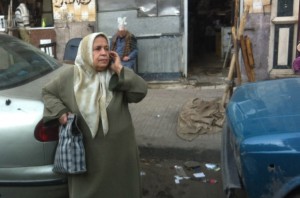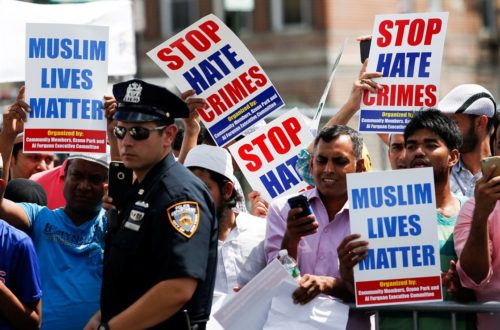Glued to the TV for the glorifying 18 days of the January 25th, 2011 Egyptian Revolution, I was boxed in the hyped coverage of the Tahrir drama: the day of fury, the battle of the camels, the stubborn dictator, the man behind Omar Suleiman, the killing of peaceful protestors, the Sylmaya Sylmaya chanting, the Egyptians’ resilience and their brilliant sense of political humor, the irhel (leave) signs”, Obama’s wait-and see attitude, the speech, the stepping down of a dictator, the end of a 30-year dictatorship, all unfolding live and before my eyes. After the dust had settled, al Jazeera moved on to other stops on the Arab Spring freedom trail, and the western media returned back to their bases. However, the revolution has not ended. Fifteen months later, the Egyptians are still going at it, protesting at Tahrir Square and elsewhere, people still willing to die for their freedom. I decided to take my own camera and follow the Egyptian Freedom Trail, to document this event through my own eyes.
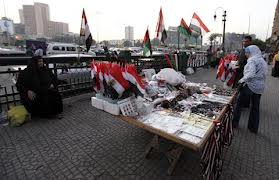
The eight-hour flight to Paris was long but uneventful; the landing was smooth, and even the five- hour layover at the Paris airport was a welcome rest. Then came the shorter flight to Cairo, which was an interesting one, a harbinger of things to come, perhaps. A few minutes after I was seated , my first row mate appeared, a high-ranking Egyptian Coptic cleric; he looked like a pope to me, fully dressed in his religious costume. A few minutes later an Afghani “Salafy” man arrived to claim the other seat. I learned later that he was going to Saudi Arabia on his “Omarah”, the off season hajj. I introduced myself and the two to each other and commented to the jokingly, “We have 4 hour flight, so we need to talk to each other.” Needless to say, we had a ball, mostly talking about Egypt and the Egyptian sense of humor, occasionally interrupted by a few interfaith dialogs. We exchanged phones numbers and wished each other luck on our individual journeys.
I landed at Cairo International Airport on Thursday, the 5th of April, at 5:30 pm. The airport staff were helpful and friendly. “Welcome home,” said the female security guard after a quick glimpse at my American passport. I didn’t tell my family of my arrival time, so only my friend Said was waiting for me. Immediately, I started observing people all around me, trying to see the signs that people have changed after the revolution. I was watching their eyes, their movements, how they spoke, how they asked questions. Would they ask for baksheesh (tips) as before? I was desperately looking for any clue to the post revolution and post Mubarak era.

But first things first, I was eager to stop at Tahrir Square, in spite of all advice against it. “We don’t know who is in Tahrir now, lots of thugs, or Baltagiyah, are making it their permanent home” said my friend Said. The next day was Friday, April 6th, and the people were gearing for another one-million man march, the Salafy supporters flexing their muscle in support of their presidential front runner Hazem Abu Ismail. “You can go and see for yourself then,” Said advised me . Driving home, things looked normal in the streets. People seemed to be minding their own business dealing with the normal heavy traffic, left to fend for themselves, they feel free to do anything they want. The streets seemed for the first time remarkably void of any police or security with just a few army tanks present around some government buildings. Everywhere you look, the walls were covered by anti Mubarak, anti government, and anti military graffiti; revolutionary art covered the decay of the old Cairo buildings making the city look new and vibrant again . After 5000 years, Egyptians had re-discovered their ancient trade, writing their stories on the walls.
TAHRIR VISIT
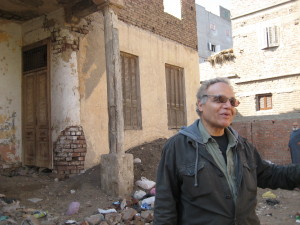
At one p.m. the next day, I woke up in my sister’s 6th floor apartment in a building on a small street just a few blocks from Tahrir Square. I washed and had breakfast. It was a Friday afternoon in April, but through the shuttered windows, I could feed the air was hot like summer. The family’s mood was tense; people didn’t know what to expect during this molyoniyah (one-million man march). It was the first one after a truce had been struck between protestors and police security, the tens of people who were killed in Maspero, the Magles Elshaab strike, the Mohamed Mahmoud street protest and the Port Said massacres, all fresh memories. I was a little worried as this was my first Tahrir visit post revolution. I had been there in ‘72 for a general sit-in during Sadat’s era and had learned firsthand about police brutality, but I had been younger then. Now, I didn’t know what to do or how it was going to turn out. I needed to be fully prepared, so I brought my own Tahrir “survival kit” from the States. Good sturdy tennis shoes, a hoody, strong jeans with lots of pockets, sweets and snacks, pepper spray, and small Bloggie camera and, of course, my old, expired Egyptian passport to use as I.D., just in case. “Keep the American one at home,” I was advised. The anti-American sentiment was high that week. The NGO military raids had just taken place a few weeks before. I also was equipped with two of my twenty-something nephews, Islam (a Salafy and Hazem Abu Ismail supporter) who actually was one of the organizers for the event and waiting for us at Tahrir, and Mohamed (a Muslim Brotherhood supporter) and the one who had been in the trenches from the beginning. “I know all the police and officers in our street,” he said. He was one of the community leaders during the revolution, forming a community policing force, and had been in Tahrir tons of time. He was my Tahrir guru throughout my visit to Egypt. ”Uncle, don’t speak to them, your Arabic is broken, I’ll do all the talking,” he always joked every time we visited Tahrir.
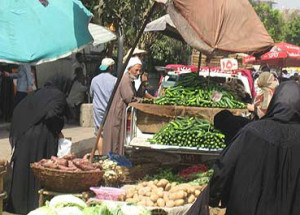
Since the apartment building is located such a short distant from Tahrir, we practically could hear the protestors chanting from home. It has been in the midst of everything since the revolution began a year and half ago. Looking down from the balcony window, I could take in the scene: there was a tank, police in full riot gear, protestors, a hunger strike tent, people chanting anti-military songs, young soccer fan ultras having a sit-in strike and chanting. We gathered at the front of our building and started walking at about 3:45pm toward Tahrir. The scouting report indicated that the Square was getting full, and my Salafy guy, Islam, called and gave us the go-ahead sign. “Where are you? Everything is going well here,” he said. “Walk purposefully and don’t look at any soldiers. Just ignore them as if they aren’t there,” Mohamed told me. We reached Qasr Elaini Street, the main artery to Tahrir Square. Already the flow of demonstrators was overwhelming with people coming from everywhere. The street was blocked by barbed wire with only a crack for an opening to keep an orderly entry. People were so excited; everyone was talking, joking and patiently waiting for their turn. It was so amazing to me that all those people, from all walks of life, and all factions, were just taking this all in stride. The Tahrir movement was bigger than anyone’s affiliation and verbal confrontations were put to rest in a hurry. As we approached the square, I was actually trembling, excited, my heart beat was racing. ‘This is it,’ I thought. ‘This is the place that 15 months ago had witnessed the most amazing historical event in Egypt history.’ That night Tahrir was gearing for another molyoniyah called for by the supporters of their new Salafy presidential front runner, Hazem Abu Ismail. The Salafy are those ultra-conservative Islamists who want to take Islam back to its original core of Salafis, (descendants of the prophet Mohammed). They are growing in number and confidence in post-revolution Egypt.

They have mostly avoided politics for the last 30 years, and have been financed and supported by Saudi money and Wahhabi ideas. They won 25% in the first parliamentary election, and represent a much larger though less-organized group than the well-established Muslim brotherhood. The Brotherhood, which won 47% of the seats, are the strongest political faction in Egypt now with more political experience and organizational skilled. But today’s Molyoniah is a Salafy one. Their number is overwhelming as they walk chanting with their long beards wearing their traditional short robes. Their leader, Hazem Abu Ismaeil, has become a pop-star phenomenon. People were so eager to find a hero, and he was willing to take that role. His name became a household word overnight. In just a few weeks, his posters spread everywhere, on cars, buildings, mosques, street posts, T-shirts, foreheads, even on motorcycles and bikes. He had become the Obama agent of change for lots of Egyptians. His support crossed over the Salafy hard-core lines. His political campaign was slick and modern, with massive marketing memorabilia. His slogans, Sawf Nahia Krama , “We shall live with dignity,” captured people’s imagination. After 30 years of humiliation by ex-dictator Mubarak, people were reenergized again. “He is the only one who will bring our dignity back,” said a 43-year-old Hassan Salah, an elementary school teacher. Ismail’s wide appeal wasn’t because of his conservative views. On the contrary, it was based on his modern appeal and sense of humor. He is not the typical bearded Jihadist type that media would like to flash on the 5 o’clock news. When he was asked in a press conference why his posters were covering 2/3 of Egyptian streets, he fired back, “Give me one more year, I will cover the other third.” His popularity was spreading like wild fire. Then came the issue of his mother’s nationality, and suddenly, the military had to react; they couldn’t tolerate such serious opposition. The fiasco arose over the fact that Abu Ismail’s mother had lived in the US and held dual citizenship. That, according to the Egyptian constitution, disqualified him from running in the presidential race. This Constitutional Amendment was made during a referendum that the military shoved down the Egyptian’s throats after the revolution.
More than 70% approved with wide support from the Salafy and Islamist movement. Abu Ismail himself supported the amendment, but most people didn’t even know what they were agreeing to, I was told. In quick succession, ultraconservative Islamist candidate Hazem Abu Ismail, front runner Khairat el-Shater of the Muslim Brotherhood, and former intelligence chief, Omar Suleiman, were knocked out of the race along with seven others on legal grounds. “Omar Suleiman finished his last act and service to the country,” Osam Jad, a poet and activist explained sarcastically, talking about the former chief of intelligence of ex-dictator Mubarak, the mastermind of all wheeling and dealing with Israel and the Palestinian peace process, as well as American favorite rendition program guy. The one who once cut off the hand of an Al Qaida suspect and sent it to the American intelligence to check his fingerprints.
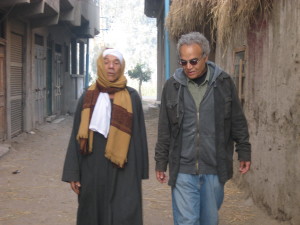
During my stay in Egypt, I attended three major Molyaniyahs at Tahrir Square. The one I described was organized by the Salafy faction, another was by the well-organized Muslim Brotherhood, Ahkwan, and the last one by all factions and political groups, called “Save the Revolution Day,” which was the most impressive one, where I met people from all over Egypt. Everyone was talking, every faction featuring their own grand stands, and most people were shopping around for new ideas.Debates were taking place everywhere. I saw a Salafy surrounding by a hostile crowd, while he remained calm and deliberate. He asked everyone to give him a chance to explain his views, and they did. Soon people started laughing and he joined the crowd.
Egypt has changed so much now that people aren’t afraid of the government; instead, it is the other way around. People were waving their flags and banners. On all my visits to Tahrir Square and other demonstrations, I never saw any violence from the crowd. “We only have violence when we have police or military present,” explained Khaled Abol Naga, Egyptian Tahrir prince and filmmaker. In every Molyoniah, Tahrir looked like a huge carnival of ideas and grievances. The Square has its own reverence now, and people respect it since it symbolizes the revolutionary spirit. Any altercations were dealt with promptly. People know it is a place for everyone to come and feel safe to speak and express their views. More than anything, it symbolizes the anti-Mubarak era. I asked my nephew Islam, a devoted Salafy, if we could stop at one of the liberal tents, “Revolution Coloration” as their sign says. Although it was a Salafy Molyaniaya Friday, the other groups had never left Tahrir since the stepping down of ex-dictator Mubarak. “We are staying here until the revolution achieve its objectives,” said Ahmed Mohamed, one of the organizers. Once we got closer to their tent, one of the groups saw my nephew and the Hazem Abu Ismail sign he carried, and he immediately started pushing him away. He had a spray in his hand, and started spraying him as if he was chasing away flies. My nephew was cool and just smiled and stepped away from the tent. Another organizer rushed from inside the tent and offered an apology, “I’m so sorry,” he told us, “you both welcome to our tent.”
PEOPLE OF TAHRIR
At Tahrir, I met so many wonderful people with great ideals; people who for the first time feel free to talk about their own country without fear of persecution; people with strong opinions and strong suspicions of each other’s views. Yes, the Islamists are growing in Egypt but in spite of their extreme views, I found them much easier to talk to than the so-called tolerant liberals. Here I’m talking about the street Salafy, the ones who, like everyone else, want a better Egypt for everyone, not just the Military elite. “During Mubarak, corruption was rampant. What we need now is more of moral leader,” explained to me Hassan Heggazi, who came all the way from Suhag in southern Egypt to support the Abu Ismail campaign. The street Salafy are gaining confidence as their voice gets stronger, their beards get longer, their robes get shorter, but they need to win the people over.
